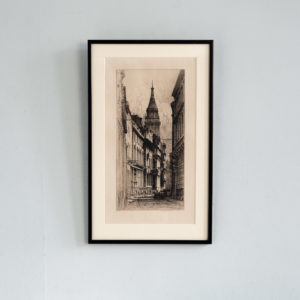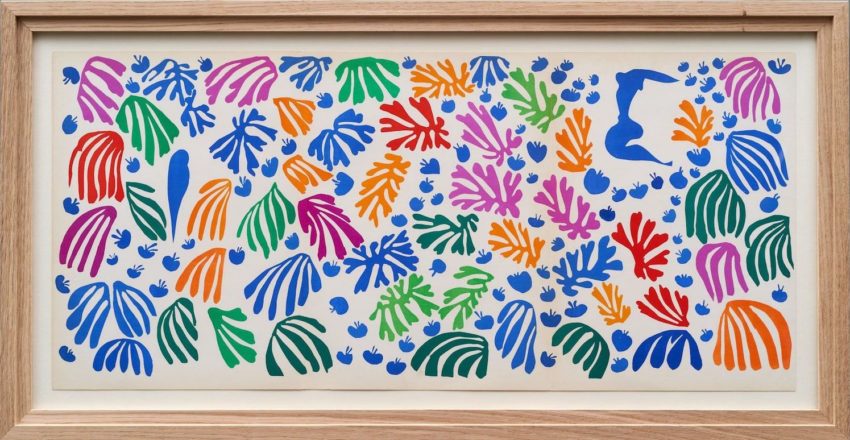
Art, Prints & Sculpture
Explore the full breadth of our decorative Works of Art. We have everything from numbered runs of prints and lithographs to original paintings and sketches. We specialise in London maps, including tube maps and plans of the City. Also lithographs by renowned Twentieth Century artists. You will find three dimensional sculpture in marble, bronze, plaster and more. Taxidermy and trophies are found alongside driftwood and weathervanes. Those in need of more functional pieces will discover shopkeepers and trade sign boards.
1410 items found
-
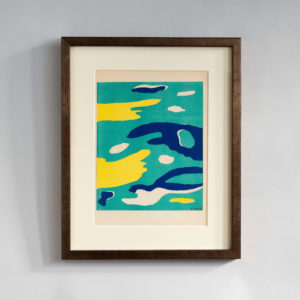
The Four Elements, Water by Fernand Leger, Verve Vol. 1 / No. 1.
£600The Four Elements, Water by Fernand Leger, Verve Vol. 1 / No. 1.
The Verve Review was a purposefully luxurious. It ran from 1937 to 1960, but with only 38 editions available, due to the high degree of design and editorial work dedicated to each issue. Each edition contained unique lithographic prints, commissioned by the editor, and each cover a double-page lithograph elaborated by one of the artists contained within. It was the brainchild of its editor Stratis Eleftheriades, a Greek National who moved to Paris in the early thirties to take part in the growing Modernist movement, writing under the name of Teriade.£600 -
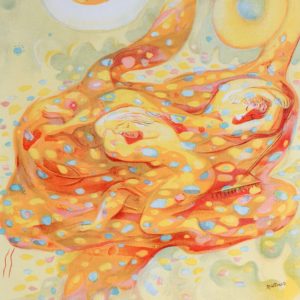
Autumn by Abraham Rattner, Verve Vol. 1 / No. 3.
£600Autumn by Abraham Rattner, Verve Vol. 1 / No. 3.
The Verve Review was a purposefully luxurious. It ran from 1937 to 1960, but with only 38 editions available, due to the high degree of design and editorial work dedicated to each issue. Each edition contained unique lithographic prints, commissioned by the editor, and each cover a double-page lithograph elaborated by one of the artists contained within. It was the brainchild of its editor Stratis Eleftheriades, a Greek National who moved to Paris in the early thirties to take part in the growing Modernist movement, writing under the name of Teriade.£600 -
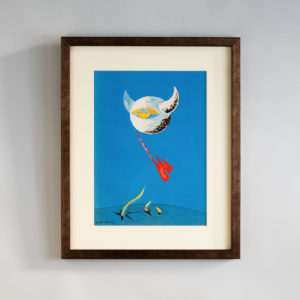
The Moon by André Masson, Verve Vol. 1 / No. 2.
£600The Moon by André Masson, Verve Vol. 1 / No. 2.
The Verve Review was a purposefully luxurious. It ran from 1937 to 1960, but with only 38 editions available, due to the high degree of design and editorial work dedicated to each issue. Each edition contained unique lithographic prints, commissioned by the editor, and each cover a double-page lithograph elaborated by one of the artists contained within. It was the brainchild of its editor Stratis Eleftheriades, a Greek National who moved to Paris in the early thirties to take part in the growing Modernist movement, writing under the name of Teriade.£600 -
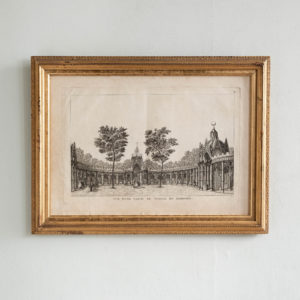
Vue D’une partie du Voxhal de Londres
£600Vue D’une partie du Voxhal de Londres
The Temple of Comus was named… after the god of cheer and good food. The building, which, although primarily devoted to dining, allowed for the appreciation of the arts and music as well as polite conversation in civilised surroundings. Initially, the building was “classical in style, with a colonnade of Ionic columns supporting a straight entablature, topped with urn finials; the semicircle flowed in a smooth curve out of the straight colonnade of the northern range of supper-boxes.” However, the designer also incorporated Gothic arches and “broad-ramped scrolls that acted as buttresses for the dome” and other unorthodox details. “The apparent breaking of architectural rules, mingling different styles in the same building, was deliberate and entirely typical of the unorthodox design of the English Rococo, which aimed to create playful, light-hearted works.”
£600 -
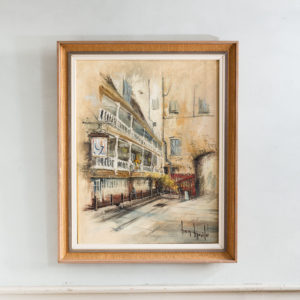
The George Inn, Borough High Street
£600The George Inn, Borough High Street
Typical heavy impasto work of Ben Maile painted in 1969. Framed£600 -
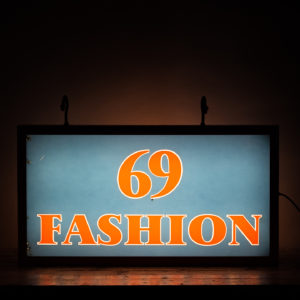
‘Fashion 69’ illuminated sign,
£600 -
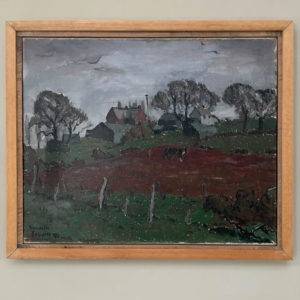
Greville Irwin, Farm Near Bollington, oil on canvas,
£595Greville Irwin, Farm Near Bollington, oil on canvas,
a rural scene on an overcast day; the paint surface appears stable, an indentation to the left inside the stretcher; the title written to the the reverse, also '(R.A. 1946)'; later oak frame and reclaimed teak slip,£595 -
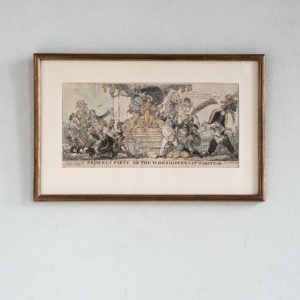
Princely Piety, or the worshippers at Wanstead,
£595Princely Piety, or the worshippers at Wanstead,
A hand-coloured etching by the caricaturist George Cruikshank depicting the wooing of a wealthy young heiress by a cast of reprobate suitors. Upon the death of her only brother James at the age of 11 in 1805 Catherine Tylney-Long became the richest commoner in England in her own right. At the tender of of 16 the 'Wiltshire Heiress' had come into a fortune of nearly £30,000,000 in today's money. This made the poor girl a prime target for every fortune hunter and indebted rake in England who wished to clear his creditors. The law as it stood in the early 19th Century had degenerated to such a degree that, under the principle of coverture, it denied a married woman any property at all in her own right while her legal existence as a feme covert was entirely subsumed in that of her husband. This left the wealthy orphan daughter of Sir James Tylney long, 7th Baronet in a difficult and precarious position, caught between the social stigma attached to unmarried womanhood and the appeals of a host of insinuating cads seeking her hand in marriage. Here Cruikshank depicts the many and assorted indigent suitors for the hand of the wealthy heiress. To the left of the dais are shown Lord Kilworth and William Wesley-Pole, later 4th Earl of Mornington a dissipated Anglo-Irish nobleman, who dueled over the courtship of Catherine. Kneeling at the foot of the steps we may also see the figure of Romeo Coates, unintentionally comic actor and 'improver' of Shakespeare included apparently 'not because of his pretensions, but his boasts and wishes'. Above him we see the fop and jobbing playwright, Sir Lumley Skeffington laying his poetic efforts at the feet of the heiress. On the right hand we see The Duke of Clarence, later William IV who by this point had debts of many hundreds of thousands of pounds holding back Baron-de-Geramb, a Spanish military adventurer and suspected Napoleonic spy who later became a Trappist monk where he used his position as procurator-general of that ancient order to defray his personal expenses. Above the Duke we see reproving the figure of Mrs Jordan, his 'common-law' wife with whom he had fathered many children at his retreat of Bushey Park. The farcical presentation of the situation belies it's tragic outcome. Perhaps cajoled by just such unkind insinuations as are repeated in this caricature Catherine would choose the worst-of-the-bunch, William Wesley-Pole, as her preferred suitor. William Wesley-Pole-Tylney-Long, as he became by Royal Licence in 1812, was an unredeemed rake and not only abused and impoverished his saintly young wife but also passed her a debilitating infection and caused her family seat at Wanstead House to be demolished and sold for salvage. After a short and unhappy marriage Catherine died at the age of only 35 after receiving a final brutal letter from her estranged husband, the contents of which apparently caused her to have some form of seizure. Frustrated in his efforts to gain custody of their son William, on whom the family fortune had devolved, William Pole Tylney-Long-Wellesley, 4th Earl of Mornington (the final name by which he was known) died in 1857 unwept, unhonoured and unsung if also unrepentant. His obituary in the Morning Star described him as "A spendthrift, a profligate, and a gambler in his youth, he became debauched in his manhood... redeemed by no single virtue, adorned by no single grace, his life gone out even without a flicker of repentance".£595 -
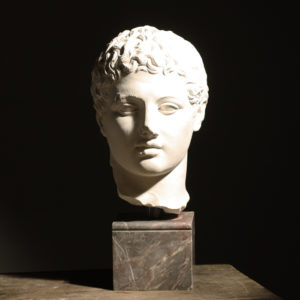
The head of a Young Athlete,
£595The head of a Young Athlete,
the young male with curly hair, almost certainly from a statue, mounted on an Ashburton marble block,£595 -
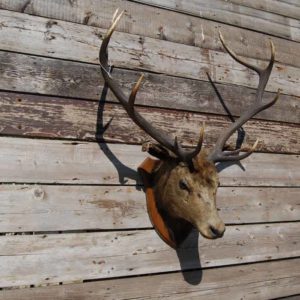
A ten point red deer stag’s head trophy
£595 -
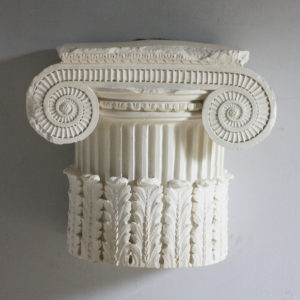
An English relief cast Greek Ionic Order capital,
£595An English relief cast Greek Ionic Order capital,
the capital with flat fronted volutes and stop-fluted and stiff-leaf ornament to the stem,£595 -
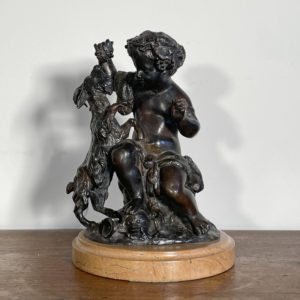
A cast bronze group of the young Bacchus with goat,
£580A cast bronze group of the young Bacchus with goat,
the young deity with vine leaf garland, his foot rested on a drained ewer, feeding grapes to the standing ruminant, mounted on a circular marble base,£580 -
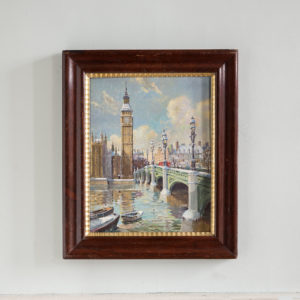
Palace of Westminster
£580Palace of Westminster
Bert Pugh (1904-2001) sometimes known as Sullivan Pugh, born in Kilmarnock, Ayrshire. When he was young his family moved to London, where he spent much of his life, joining the Chelsea Art Club. Pugh studied for three years at a building school, at 17 becoming an architectural and ecclesiastical draughtsman, church craftsman and woodcarver, afterwards designing bookplates and practising calligraphy. While owning a commercial art studio in the Strand, he spent evenings studying from life and painting and began to exhibit in the capital. Pugh also spent some time as a commercial artist with the advertising agency J. Walter Thompson.£580 -
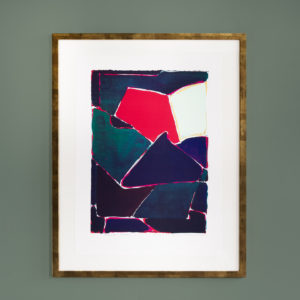
Black Hill, by Gordon House
£575 eachBlack Hill, by Gordon House
Gordon House was a graphic designer and abstract painter. He went to art school in Luton, then later, won a scholarship to St. Albans. During the 1950’s he spent much time in Letchworth, Welwyn and working for Imperial Chemical Industries (ICI) becoming aware of a modernist style of graphics through the design of European pharmaceutical packaging. This style was new to British eyes at the time and he went on to design the graphics for many galleries during the 1960’s. Mixing in new circles he collaborated with leading artists like Peter Blake and Richard Hamilton. He was responsible for the white on white emboss of the band’s name across the record sleeve on the Beatles White album against the wishes of Hamilton, who wanted to leave the sleeves totally blank, save for the stamp of a unique issue number. The Tate Gallery holds more than 100 of his prints and his work is also represented in many important public collections including the Arts Council, the British Council, the Victoria & Albert Museum and the M.O.M.A. in New York.£575 each -
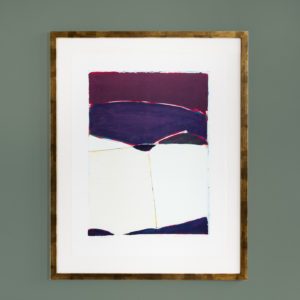
Black Hill, Pages, by Gordon House
£575 eachBlack Hill, Pages, by Gordon House
Gordon House was a graphic designer and abstract painter. He went to art school in Luton, then later, won a scholarship to St. Albans. During the 1950’s he spent much time in Letchworth, Welwyn and working for Imperial Chemical Industries (ICI) becoming aware of a modernist style of graphics through the design of European pharmaceutical packaging. This style was new to British eyes at the time and he went on to design the graphics for many galleries during the 1960’s. Mixing in new circles he collaborated with leading artists like Peter Blake and Richard Hamilton. He was responsible for the white on white emboss of the band’s name across the record sleeve on the Beatles White album against the wishes of Hamilton, who wanted to leave the sleeves totally blank, save for the stamp of a unique issue number. The Tate Gallery holds more than 100 of his prints and his work is also represented in many important public collections including the Arts Council, the British Council, the Victoria & Albert Museum and the M.O.M.A. in New York.£575 each -
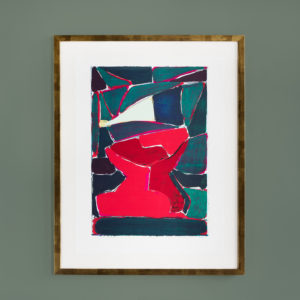
Black Hill, Rostra, by Gordon House
£575 eachBlack Hill, Rostra, by Gordon House
Gordon House was a graphic designer and abstract painter. He went to art school in Luton, then later, won a scholarship to St. Albans. During the 1950’s he spent much time in Letchworth, Welwyn and working for Imperial Chemical Industries (ICI) becoming aware of a modernist style of graphics through the design of European pharmaceutical packaging. This style was new to British eyes at the time and he went on to design the graphics for many galleries during the 1960’s. Mixing in new circles he collaborated with leading artists like Peter Blake and Richard Hamilton. He was responsible for the white on white emboss of the band’s name across the record sleeve on the Beatles White album against the wishes of Hamilton, who wanted to leave the sleeves totally blank, save for the stamp of a unique issue number. The Tate Gallery holds more than 100 of his prints and his work is also represented in many important public collections including the Arts Council, the British Council, the Victoria & Albert Museum and the M.O.M.A. in New York.£575 each -
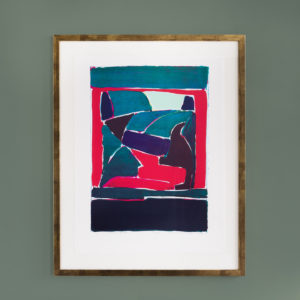
Black Hill, Work Shop, by Gordon House
£575 eachBlack Hill, Work Shop, by Gordon House
Gordon House was a graphic designer and abstract painter. He went to art school in Luton, then later, won a scholarship to St. Albans. During the 1950’s he spent much time in Letchworth, Welwyn and working for Imperial Chemical Industries (ICI) becoming aware of a modernist style of graphics through the design of European pharmaceutical packaging. This style was new to British eyes at the time and he went on to design the graphics for many galleries during the 1960’s. Mixing in new circles he collaborated with leading artists like Peter Blake and Richard Hamilton. He was responsible for the white on white emboss of the band’s name across the record sleeve on the Beatles White album against the wishes of Hamilton, who wanted to leave the sleeves totally blank, save for the stamp of a unique issue number. The Tate Gallery holds more than 100 of his prints and his work is also represented in many important public collections including the Arts Council, the British Council, the Victoria & Albert Museum and the M.O.M.A. in New York.£575 each -
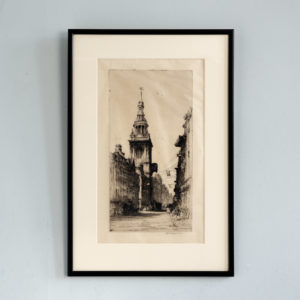
Nathaniel Sparks, St Mary-le-Bow, Cheapside,
£570Nathaniel Sparks, St Mary-le-Bow, Cheapside,
An original dry-point engraving by the artist and painter-etcher Nathaniel Sparks showing the steeple of St Mary le Bow viewed looking west up Cheapside. Signed by the artist. Presented in a cream mount and black frame.£570 -
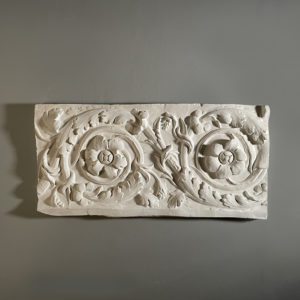
A cast plaster section of foliate scroll frieze
£560 -
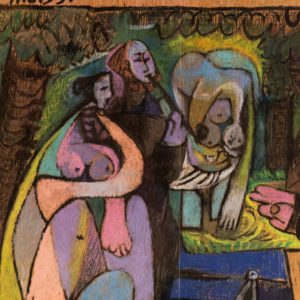
Pablo Picasso, Lithograph based on Edouard Manet’s, Luncheon on the the Grass. c1962
£550Pablo Picasso, Lithograph based on Edouard Manet’s, Luncheon on the the Grass. c1962
From 1959-1962 Pablo Picasso and his second wife Jacqueline lived at Château de Vauvenargues near Aix-en-Provence. He spent most of his time of his time on 140 drawings and 27 paintings, lino-cuts and cardboard models all on the theme of Manet’s, Le Déjeuner sur l’herbe. Manet's original painting from 1862 showing a nude woman sitting between two fully clothed men was a scandal for the time.£550 -
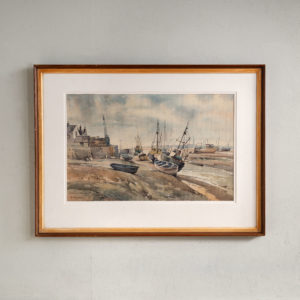
Leigh on Sea, Albert Houghton
£550Leigh on Sea, Albert Houghton
Mounted and framed watercolour painting by the English artist and painter, Albert Houghton showing fishing boats at Leigh on Sea, Essex. 1970, signed by the artist.£550 -
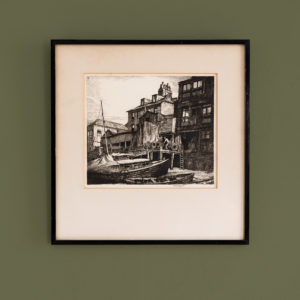
Buildings & Boats
£550Buildings & Boats
A framed and mounted black line etching by the artist-engraver Norman Jones RWS RE RSMA, showing a riverside wharf scene in the Lower Pool of the River Thames, possibly corresponding to the river frontage of Narrow Street, Limehouse. Signed in pencil by the artist.£550 -
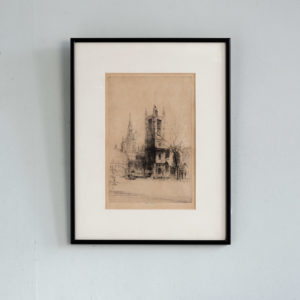
Frederick Farrell, St. Margarets Church, Westminster,
£550Frederick Farrell, St. Margarets Church, Westminster,
A framed and mounted original etching by Frederick Arthur Farrell depicting St Margaret's Church Westminster from across Parliament Square. Hand signed by the artist in pencil.£550 -
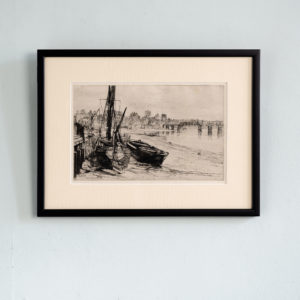
Charles Watson, Chelsea
£550Charles Watson, Chelsea
A framed and mounted etching by the English artist Charles Watson (1846-1927) depicting the foreshore at Chelsea with two barges at low tide. In the distance is shown the tower of Chelsea Old Church and a part of Old Battersea Bridge, replaced in 1890. The vantage is from close to the current site of the Chelsea Yacht and Boat Yard. Signed on the plate.£550 -
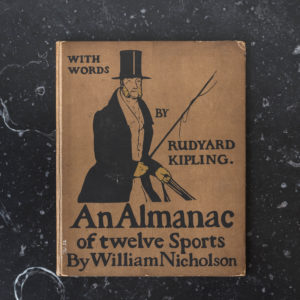
An Almanac of Twelve Sports by William Nicholson,
£550An Almanac of Twelve Sports by William Nicholson,
The Almanac was first published by Heinemann in London for Christmas 1897 with a calendar for the year 1898. Sir William Nicholson was a late 19th Century painter and print-maker. His experiments with woodcut printing encouraged the development of his distinctive pictorial style. After making his name with a series of twelve portraits of public figures (which won a gold medal at the 1900 Exposition Universelle in Paris) he moved on to produce this Almanac of twelve sports for his new publisher, Heinemann. The accompanying text was provided by the poet Rudyard Kipling. Kipling was not an enthusiastic sportsman, in fact he derided 'flannelled fools at the wicket' and 'muddied oafs at the goal' in his poem The Islanders however, after sitting for a Nicholson portrait, he agreed to provide a set of short poems to match the depicted sports. Kipling adopted a concise and suggestive style for the poems, harking back to his Departmental ditties of the 1880's. One verse at least, the draft couplet for the coaching party depicted in August, was considered too suggestive by half and was excised by Heinemann as unsuitable for the family audience he had in mind:'Youth on the box and liquor in the boot / My Lord drives out with my Lord's prostitute.'
£550 -
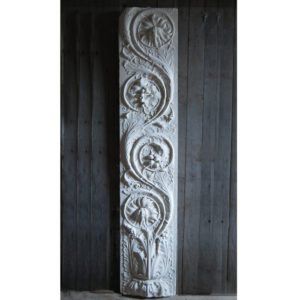
An English cast plaster relief panel,
£545An English cast plaster relief panel,
the richly ornamented frieze cast with an acanthus clasp issuing four successive fruiting and flowering acanthus scrolls,£545 -
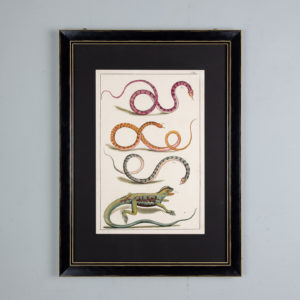
Snakes by Albertus Seba (1665-1736)
£540 eachSnakes by Albertus Seba (1665-1736)
Published to illustrate Seba's 'cabinet of curiosities' Framed£540 each -
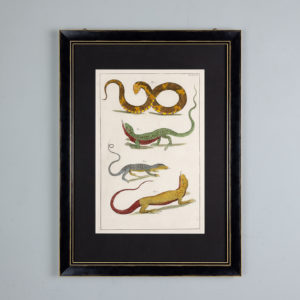
Snakes by Albertus Seba (1665-1736)
£540 eachSnakes by Albertus Seba (1665-1736)
Published to illustrate Seba's 'cabinet of curiosities' Framed£540 each -
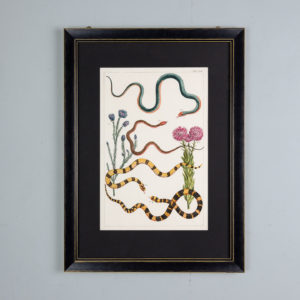
Snakes by Albertus Seba (1665-1736)
£540 eachSnakes by Albertus Seba (1665-1736)
Published to illustrate Seba's 'cabinet of curiosities' Framed£540 each -
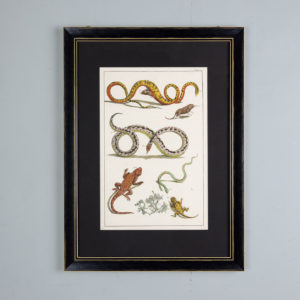
Snakes by Albertus Seba (1665-1736)
£540 eachSnakes by Albertus Seba (1665-1736)
Published to illustrate Seba's 'cabinet of curiosities' Framed£540 each -
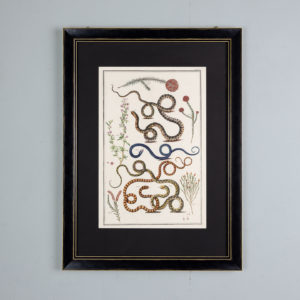
Snakes by Albertus Seba (1665-1736)
£540 eachSnakes by Albertus Seba (1665-1736)
Published to illustrate Seba's 'cabinet of curiosities' Framed£540 each -
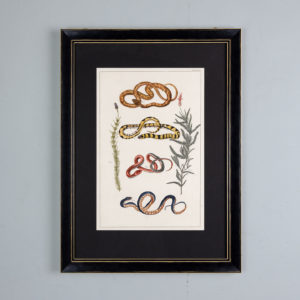
Snakes by Albertus Seba (1665-1736)
£540 eachSnakes by Albertus Seba (1665-1736)
Published to illustrate Seba's 'cabinet of curiosities' Framed£540 each -
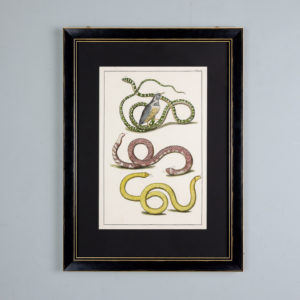
Snakes by Albertus Seba (1665-1736)
£540 eachSnakes by Albertus Seba (1665-1736)
Published to illustrate Seba's 'cabinet of curiosities' Framed£540 each -
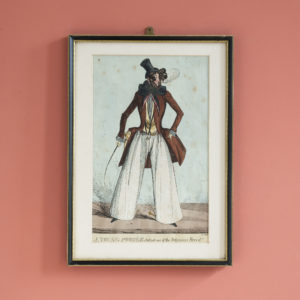
‘A Young Poodle, but not one of the Sagacious Breed’
£520‘A Young Poodle, but not one of the Sagacious Breed’
Caricaturist, presumably of Irish background, but undocumented. Responsible for a small number of plates in a distinctive hand. Unclear whether he etched them all or only designed them. Never a publisher. Worked for P.Roberts and J.Aitken. Many unsigned prints by both men may well be by him.£520 -
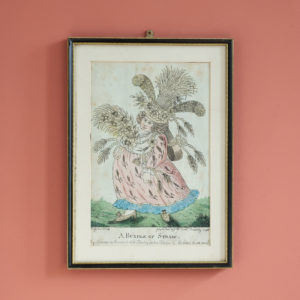
A Bundle of Straw, My Spouse is Remarkable Tasty in his Dress & he likes to see me so.
£520A Bundle of Straw, My Spouse is Remarkable Tasty in his Dress & he likes to see me so.
Caricaturist, presumably of Irish background, but undocumented. Responsible for a small number of plates in a distinctive hand. Unclear whether he etched them all or only designed them. Never a publisher. Worked for P.Roberts and J.Aitken. Many unsigned prints by both men may well be by him.£520 -
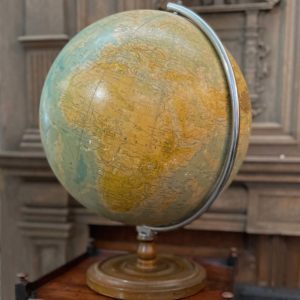
A large English library globe,
£520A large English library globe,
the 19" globe with chromed semi-meridian, mounted on a turned, stained beechwood base, marked and stained with age and use,£520 -
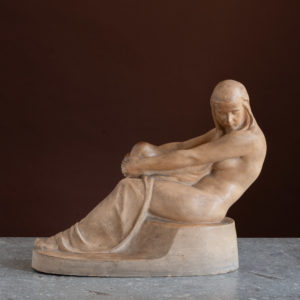
Art Deco Terracotta Mantle Figure of a Reclining Female.
£500Art Deco Terracotta Mantle Figure of a Reclining Female.
The patinated cast terracotta figure of a reclining female, head bowed, with one leg drawn towards her, and draped material over her legs. An indecipherable signature to base. Possible French.£500 -
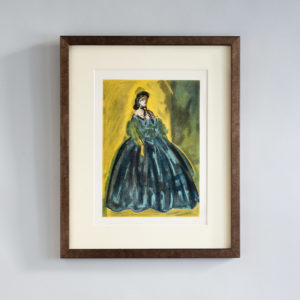
Portraits Part II by Constantin Guys, Verve Vol 2 / No. 5-6.
£500Portraits Part II by Constantin Guys, Verve Vol 2 / No. 5-6.
The Verve Review was a purposefully luxurious. It ran from 1937 to 1960, but with only 38 editions available, due to the high degree of design and editorial work dedicated to each issue. Each edition contained unique lithographic prints, commissioned by the editor, and each cover a double-page lithograph elaborated by one of the artists contained within. It was the brainchild of its editor Stratis Eleftheriades, a Greek National who moved to Paris in the early thirties to take part in the growing Modernist movement, writing under the name of Teriade.£500 -
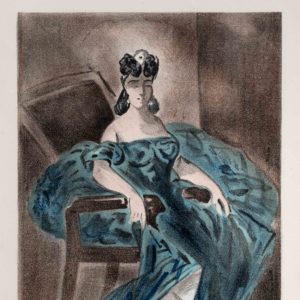
Portraits Part I by Constantin Guys, Verve Vol 2 / No. 5-6.
£500Portraits Part I by Constantin Guys, Verve Vol 2 / No. 5-6.
The Verve Review was a purposefully luxurious. It ran from 1937 to 1960, but with only 38 editions available, due to the high degree of design and editorial work dedicated to each issue. Each edition contained unique lithographic prints, commissioned by the editor, and each cover a double-page lithograph elaborated by one of the artists contained within. It was the brainchild of its editor Stratis Eleftheriades, a Greek National who moved to Paris in the early thirties to take part in the growing Modernist movement, writing under the name of Teriade.£500 -
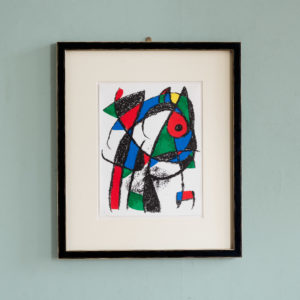
Joan Miró, Lithographie originale
£500Joan Miró, Lithographie originale
Joan Miró produced nearly 1,800 original lithographs and prints at the Maeght studio. He composed his score, invented his alphabet, scattered his symbols across the white page of his writing, close to graffiti. Everything was free, released, aerial, penetrated with interior light. He celebrated marriages between all techniques. Nothing was ever excessive or gratuitous. His creation cut to the essential. Miró created his own language. Dots, lines, scratches, graffiti, writing, mysterious anthropomorphic figures swimming or flying through infinite territory, fed by sparks. The power of black, awestruck colors… And the paper always defended its whiteness. Miró was about drawing above all else. His energy burst on to the sheet.£500 -
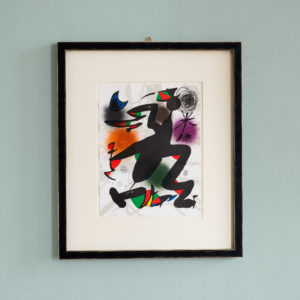
Joan Miró, Lithographie originale
£500Joan Miró, Lithographie originale
Joan Miró produced nearly 1,800 original lithographs and prints at the Maeght studio. He composed his score, invented his alphabet, scattered his symbols across the white page of his writing, close to graffiti. Everything was free, released, aerial, penetrated with interior light. He celebrated marriages between all techniques. Nothing was ever excessive or gratuitous. His creation cut to the essential. Miró created his own language. Dots, lines, scratches, graffiti, writing, mysterious anthropomorphic figures swimming or flying through infinite territory, fed by sparks. The power of black, awestruck colors… And the paper always defended its whiteness. Miró was about drawing above all else. His energy burst on to the sheet.£500 -
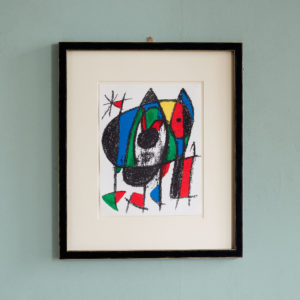
Joan Miró, Lithographie originale
£500Joan Miró, Lithographie originale
Joan Miró produced nearly 1,800 original lithographs and prints at the Maeght studio. He composed his score, invented his alphabet, scattered his symbols across the white page of his writing, close to graffiti. Everything was free, released, aerial, penetrated with interior light. He celebrated marriages between all techniques. Nothing was ever excessive or gratuitous. His creation cut to the essential. Miró created his own language. Dots, lines, scratches, graffiti, writing, mysterious anthropomorphic figures swimming or flying through infinite territory, fed by sparks. The power of black, awestruck colors… And the paper always defended its whiteness. Miró was about drawing above all else. His energy burst on to the sheet.£500 -
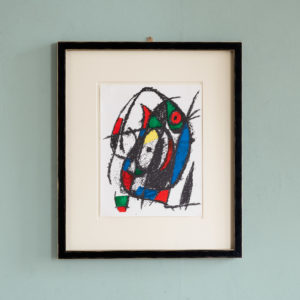
Joan Miró, Lithographie originale
£500Joan Miró, Lithographie originale
Joan Miró produced nearly 1,800 original lithographs and prints at the Maeght studio. He composed his score, invented his alphabet, scattered his symbols across the white page of his writing, close to graffiti. Everything was free, released, aerial, penetrated with interior light. He celebrated marriages between all techniques. Nothing was ever excessive or gratuitous. His creation cut to the essential. Miró created his own language. Dots, lines, scratches, graffiti, writing, mysterious anthropomorphic figures swimming or flying through infinite territory, fed by sparks. The power of black, awestruck colors… And the paper always defended its whiteness. Miró was about drawing above all else. His energy burst on to the sheet.£500 -
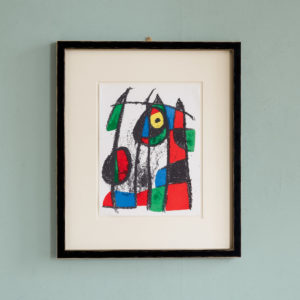
Joan Miró, Lithographie originale
£500Joan Miró, Lithographie originale
Joan Miró produced nearly 1,800 original lithographs and prints at the Maeght studio. He composed his score, invented his alphabet, scattered his symbols across the white page of his writing, close to graffiti. Everything was free, released, aerial, penetrated with interior light. He celebrated marriages between all techniques. Nothing was ever excessive or gratuitous. His creation cut to the essential. Miró created his own language. Dots, lines, scratches, graffiti, writing, mysterious anthropomorphic figures swimming or flying through infinite territory, fed by sparks. The power of black, awestruck colors… And the paper always defended its whiteness. Miró was about drawing above all else. His energy burst on to the sheet.£500 -
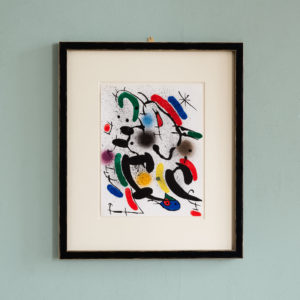
Joan Miró, Lithographie originale
£500Joan Miró, Lithographie originale
Joan Miró produced nearly 1,800 original lithographs and prints at the Maeght studio. He composed his score, invented his alphabet, scattered his symbols across the white page of his writing, close to graffiti. Everything was free, released, aerial, penetrated with interior light. He celebrated marriages between all techniques. Nothing was ever excessive or gratuitous. His creation cut to the essential. Miró created his own language. Dots, lines, scratches, graffiti, writing, mysterious anthropomorphic figures swimming or flying through infinite territory, fed by sparks. The power of black, awestruck colors… And the paper always defended its whiteness. Miró was about drawing above all else. His energy burst on to the sheet.£500 -
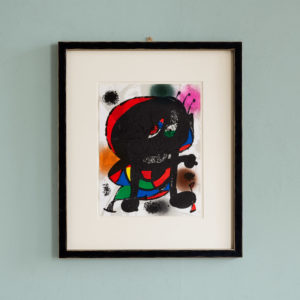
Joan Miró, Lithographie originale
£500Joan Miró, Lithographie originale
Joan Miró produced nearly 1,800 original lithographs and prints at the Maeght studio. He composed his score, invented his alphabet, scattered his symbols across the white page of his writing, close to graffiti. Everything was free, released, aerial, penetrated with interior light. He celebrated marriages between all techniques. Nothing was ever excessive or gratuitous. His creation cut to the essential. Miró created his own language. Dots, lines, scratches, graffiti, writing, mysterious anthropomorphic figures swimming or flying through infinite territory, fed by sparks. The power of black, awestruck colors… And the paper always defended its whiteness. Miró was about drawing above all else. His energy burst on to the sheet.£500 -
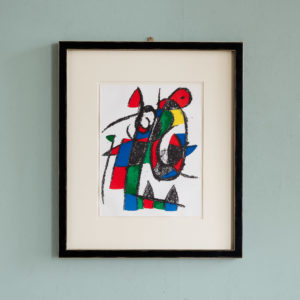
Joan Miró, Lithographie originale
£500Joan Miró, Lithographie originale
Joan Miró produced nearly 1,800 original lithographs and prints at the Maeght studio. He composed his score, invented his alphabet, scattered his symbols across the white page of his writing, close to graffiti. Everything was free, released, aerial, penetrated with interior light. He celebrated marriages between all techniques. Nothing was ever excessive or gratuitous. His creation cut to the essential. Miró created his own language. Dots, lines, scratches, graffiti, writing, mysterious anthropomorphic figures swimming or flying through infinite territory, fed by sparks. The power of black, awestruck colors… And the paper always defended its whiteness. Miró was about drawing above all else. His energy burst on to the sheet.£500 -
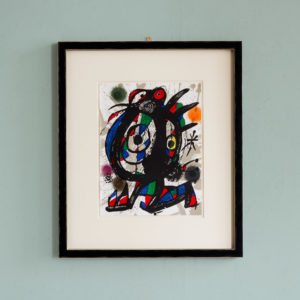
Joan Miró, Lithographie originale
£500Joan Miró, Lithographie originale
Joan Miró produced nearly 1,800 original lithographs and prints at the Maeght studio. He composed his score, invented his alphabet, scattered his symbols across the white page of his writing, close to graffiti. Everything was free, released, aerial, penetrated with interior light. He celebrated marriages between all techniques. Nothing was ever excessive or gratuitous. His creation cut to the essential. Miró created his own language. Dots, lines, scratches, graffiti, writing, mysterious anthropomorphic figures swimming or flying through infinite territory, fed by sparks. The power of black, awestruck colors… And the paper always defended its whiteness. Miró was about drawing above all else. His energy burst on to the sheet.£500 -
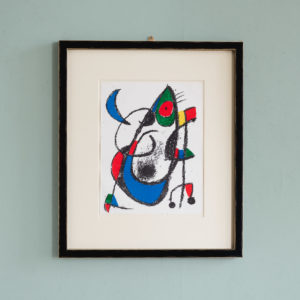
Joan Miró, Lithographie originale
£500Joan Miró, Lithographie originale
Joan Miró produced nearly 1,800 original lithographs and prints at the Maeght studio. He composed his score, invented his alphabet, scattered his symbols across the white page of his writing, close to graffiti. Everything was free, released, aerial, penetrated with interior light. He celebrated marriages between all techniques. Nothing was ever excessive or gratuitous. His creation cut to the essential. Miró created his own language. Dots, lines, scratches, graffiti, writing, mysterious anthropomorphic figures swimming or flying through infinite territory, fed by sparks. The power of black, awestruck colors… And the paper always defended its whiteness. Miró was about drawing above all else. His energy burst on to the sheet.£500 -
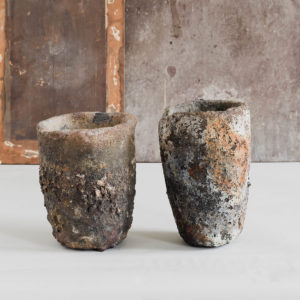
Small pair of foundry crucibles,
£500 -
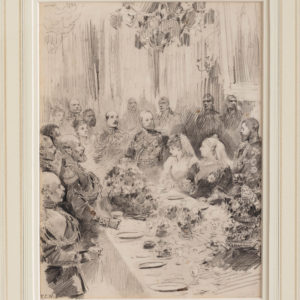
“Wedding Breakfast of the Future King George V” by Richard Caton Woodville Jr.
£495“Wedding Breakfast of the Future King George V” by Richard Caton Woodville Jr.
Richard Caton Woodville Jr. RI. ROI. (7 January 1856 – 17 August 1927) was an English artist and illustrator, was best known his historical battle scenes in the late 19th and early 20th centuries. Woodville spent most of his career working for the Illustrated London News, where he quickly developed a reputation as a talented reporter and writer.£495 -
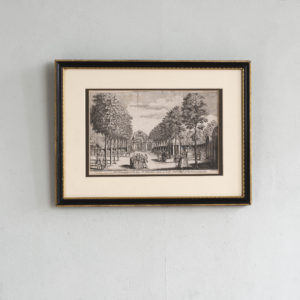
The Triumphal Arches, Mr. Handel’s Statue & c. in the South Walk of Vauxhall Gardens
£495The Triumphal Arches, Mr. Handel’s Statue & c. in the South Walk of Vauxhall Gardens
Based on the work by Samuel Wale and engraved by Benjamin Cole in 1752. Mounted and presented in a Hogarth style frame.£495 -
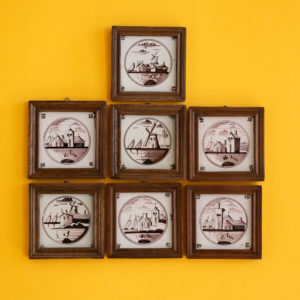
Set of seven framed antique Dutch Delft tiles. Late Eighteenth century
£490 set of sevenSet of seven framed antique Dutch Delft tiles. Late Eighteenth century
Each having moulded wooden frames, the tiles with fired manganese decoration each depicting Dutch landscape and seascape scenes of Dutch barges, windmill, harbour's and churches. Sold as a set.£490 set of seven -
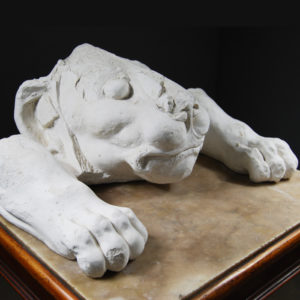
An English cast plaster of the head and fore-paws of “The Eygptian Lion”,
£485An English cast plaster of the head and fore-paws of “The Eygptian Lion”,
the lioness with bulbous eyes and soporific expression, flanked by large paws, can be wall-hung,£485 -
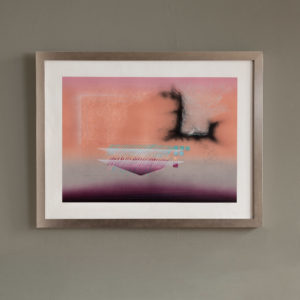
“Progress IV” artists screenprint by Anthony Benjamin (1931 – 2002)
£480“Progress IV” artists screenprint by Anthony Benjamin (1931 – 2002)
Anthony Benjamin (29 March 1931 – 17 February 2002) FRSA, RE was an English painter, sculptor and printmaker. Benjamin was a fellow of the Royal Society of Arts (FRSA) and a member of the Royal Society of Painter-Printmakers (RE)£480 -
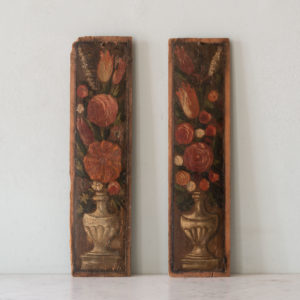
Pair of painted panels
£480 -

Westminster Abbey by Mortimer Mempes
£480Westminster Abbey by Mortimer Mempes
Mortimer Luddington Menpes. Printmaker, painter of genre, architectural subjects, and writer was born in Alelaide, Australia and came to England c.1875 where he remained until his death in 1938.£480 -
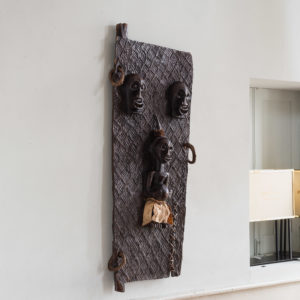
Congolese Songye door
£480 -
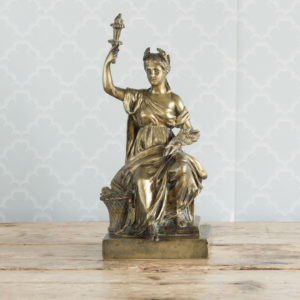
Gilt-bronze model of Ceres,
£475Gilt-bronze model of Ceres,
modelled seated holding torch aloft in one hand and with a sheaf of wheat in the other, on plinth base. Italian, nineteenth century.£475 -
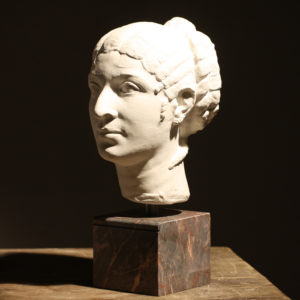
The head of Cleopatra VII (or a Ptolemaic lady),
£465The head of Cleopatra VII (or a Ptolemaic lady),
the female head, her hair elaborately coiffured, the head mounted on a block of Ashburton marble,£465 -
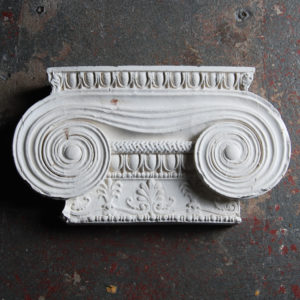
An English plaster cast of a Greek Ionic capital,
£465An English plaster cast of a Greek Ionic capital,
the spirally cast volutes above a flat pilaster header,£465 -
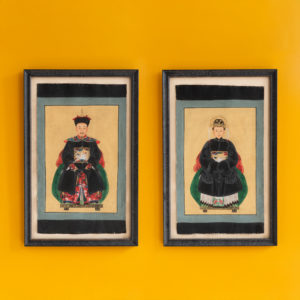
Chinese Ancestor Portraits
£450 the pairChinese Ancestor Portraits
Ancestor portraits form an important part of the Chinese practice of ancestor worship, created as near life size likenesses of the deceased. Families would honour and commemorate their ancestors, carrying out rituals and giving offerings.£450 the pair -
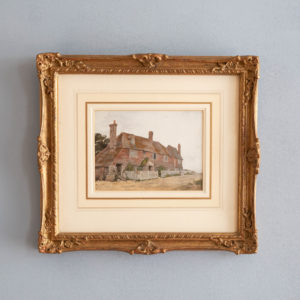
Cottages by Croydon born artist, George Edward Handel Lucas.
£450Cottages by Croydon born artist, George Edward Handel Lucas.
Original painting c1880 by George Edward Handel Lucas. Presented in a washline mount with a centre and corner gilt frame.£450 -
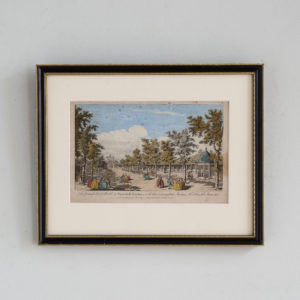
The Grand South Walk in Vaux-Hall Gardens, with the Triumphal Arches, Mr Handels Statue, &c.
£450 -
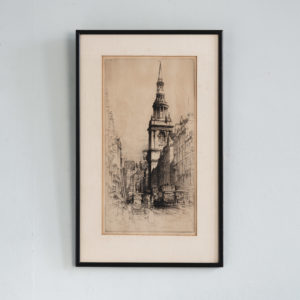
Sydney R Jones, St. Mary le Bow, Cheapside,
£450Sydney R Jones, St. Mary le Bow, Cheapside,
A mounted, framed and signed etching by the English artist Sydney R Jones (1881-1966) depicting the church of St Mary le Bow on Cheapside, London. Hand signed by the artist in pencil, bottom left, with a note that it is the '5th state' of the etching.£450 -
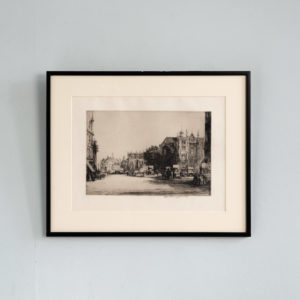
Nathaniel Sparks, Westminster from the Horseguards,
£450Nathaniel Sparks, Westminster from the Horseguards,
Mounted and in its original frame, an original dry-point engraving by the artist and painter-etcher Nathaniel Sparks showing the North Door and Lady Chapel of Westminster Abbey viewed across Parliament Square. Signed proof impression from the only edition.£450 -
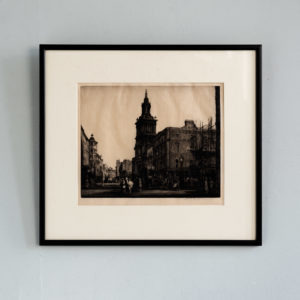
Nathaniel Sparks, St. Botolphs Church,
£450Nathaniel Sparks, St. Botolphs Church,
Mounted and in its original frame, an original dry-point engraving by the artist and painter-etcher Nathaniel Sparks showing St Botolph's church on Bishopsgate in the City of London. The corner building in the middle foreground is the White Hart Inn which had existed as a hostelry continuously on the site since 1377 until it was closed for commercial redevelopment in 2014. Signed by the artist.£450 -
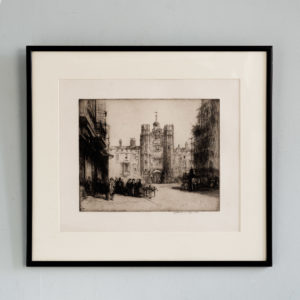
Nathaniel Sparks, St. James Palace,
£450Nathaniel Sparks, St. James Palace,
Mounted and in its original frame, an original dry-point engraving by the artist and painter-etcher Nathaniel Sparks showing the north gatehouse of St James's Palace viewed across Pall Mall from the east side of St James's Street. Signed by the artist.£450 -
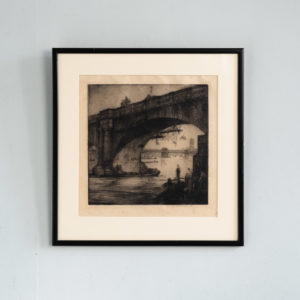
Nathaniel Sparks, Waterloo Bridge,
£450Nathaniel Sparks, Waterloo Bridge,
Mounted and in its original frame, an original dry-point engraving by the artist and painter-etcher Nathaniel Sparks showing the northernmost arch of Old Waterloo Bridge with Charing Cross and Westminster bridges beyond and the Palace of Westminster in the distance. Signed by the artist.£450 -
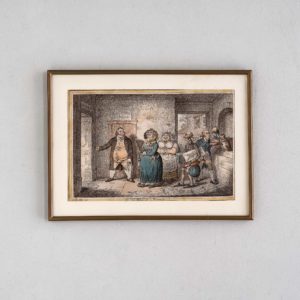
Old Maid on a Journey,
£450Old Maid on a Journey,
An original framed hand-coloured etching and engraving by caricaturist James Gillray. The corpulent figure of the independent polymath, antiquarian and collector Miss Sarah Sophia Banks is depicted being shown into the best bedroom of an Inn followed by a grotesque retinue of gurning servants carrying her assorted baggage. Miss Banks was a prolific collector of printed emphemera including broadsheets, newspaper clippings, visiting cards, caricatures, advertisements and playbills as well as being a leading numismatist of her day. Her great library of volumes on ancient coins as well as her capacious collection of the coins themselves was gifted to the nation upon her death and are now spread over the Royal Mint, The British Library and British Museum. One of the 18th Century's brilliant but unacknowledged women, Sarah Banks was the sister of the famous botanist Joseph Banks who sailed with Captain Cook to New South Wales. According to recent scholarship as well as editing her brother's manuscripts she often conversed with him on their subjects and many of her ideas were incorporated into his writings. Perhaps puzzlingly, given the warm and close friendship which was said to exist between Gillray and his wealthy female patron, Miss Banks is depicted as a obscenely fat and ugly. One can only speculate on the nature of the comedy and manners of the time (not to mention the sense of humour of the subject) when interpreting the comic effect of this print.£450 -
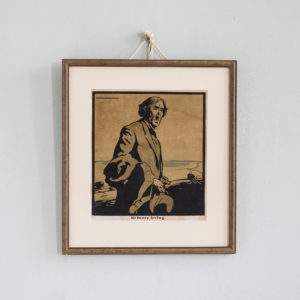
Sir Henry Irving
£450 -
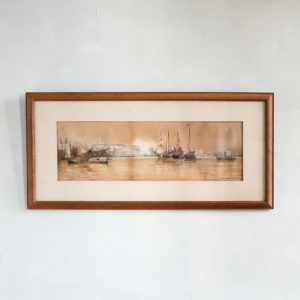
The Customs House by Thomas Bush Hardy
£450The Customs House by Thomas Bush Hardy
Showing the Pool of London with the Customs House. Signed, framed in dark wood.£450 -
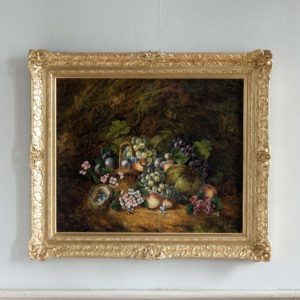
Still-life of Fruit
£450 -
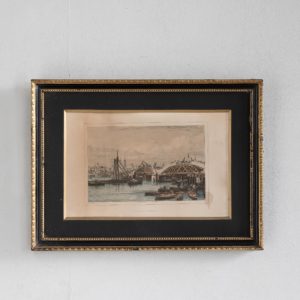
The Works of New London Bridge by Edward William Cooke RA,
£450The Works of New London Bridge by Edward William Cooke RA,
A hand-coloured engraving by George Cooke of a drawing by his son Edward William Cooke RA, from 'The Works of New London Bridge'. In 1800 it was first proposed that the inconvenient medieval bulk of old London bridge should be removed to ease traffic on the Thames and a competition was held to design a replacement. In 1824, the plans of the engineer Sir John Rennie were accepted and a site was chosen 180 feet west of the old bridge. On June 15, 1825, the Lord Mayor of London, John Garratt, laid the first block of Dartmoor granite in the presence of the Duke of York. For a short time Londoners were able to view both the old bridge and the new side-by-side. It was to be a structure of 5 arches, over 928 feet long and 49 feet wide. When the new bridge was finished and opened by King William and Queen Adelaide in 1831, traffic switched to the huge new structure and the demolition commenced on the old bridge. Edward William Cooke (1811 - 1880) was a draughtsman, illustrator, wood engraver, etcher and painter of rural and coastal scenes in oil and watercolour. In this print Cooke shows new London bridge in the middle stages of construction with the forms for the arches still in place. On the far bank of the Thames the viewer can see the Fishmongers Hall, the steeple of St Magnus the Matryr church and The Monument.£450 -
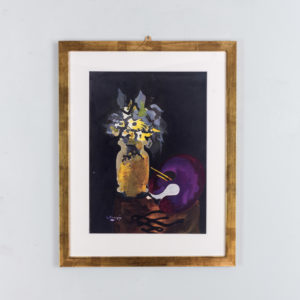
George Braque lithograph published for Verve, vol. VIII No 31/32
£450 eachGeorge Braque lithograph published for Verve, vol. VIII No 31/32
Original lithograph, published 1955 for Verve, vol. VIII No 31/32, The Intimate Sketchbooks of G. Braque. Gilt framed.£450 each -
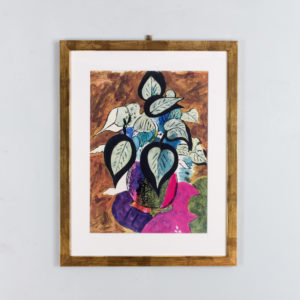
George Braque lithograph published for Verve, vol. VIII No 31/32
£450 eachGeorge Braque lithograph published for Verve, vol. VIII No 31/32
Original lithograph, published 1955 for Verve, vol. VIII No 31/32, The Intimate Sketchbooks of G. Braque. Gilt framed.£450 each -
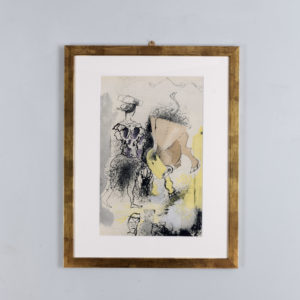
George Braque lithograph published for Verve, vol. VIII No 31/32
£450 eachGeorge Braque lithograph published for Verve, vol. VIII No 31/32
Original lithograph, published 1955 for Verve, vol. VIII No 31/32, The Intimate Sketchbooks of G. Braque. Gilt framed.£450 each -
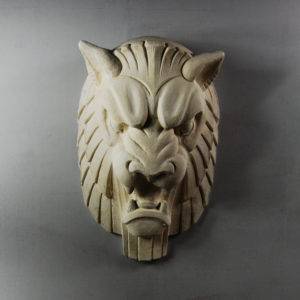
An Art Deco composition stone lion mask,
£450 -
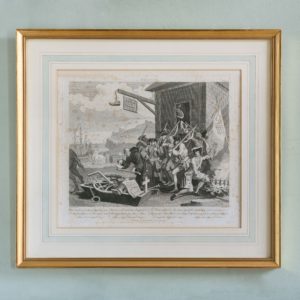
England and France, after William Hogarth published c1805
£450 the setEngland and France, after William Hogarth published c1805
Original copper-engravings presented in gilt frames with washline mounts.£450 the set -
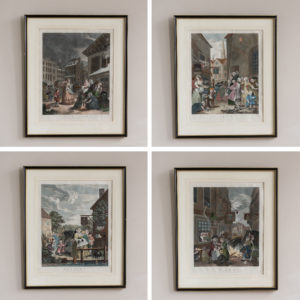
Hogarth, The Four Times of the Day
£450 the setHogarth, The Four Times of the Day
Set of four prints after William Hogarth, showing the four times of the day during different seasons of the year. Printers crease on the noon plate, published c 1805 by Thomas Cook, with old hand-colour. Framed£450 the set -
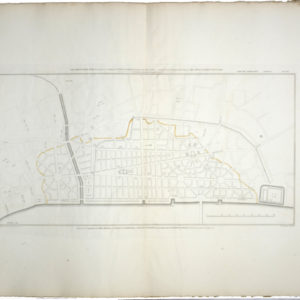
One of a series of plans and drawings referred to in the third report from the select committee upon the improvement of the Port of London
£450One of a series of plans and drawings referred to in the third report from the select committee upon the improvement of the Port of London
A framed print showing Plate XXI - "Copy of a design by Sir Christopher Wren, for re-building the City of London after the Great Fire in 1666, from an original in the library of All-Soul's College, Oxford"£450 -
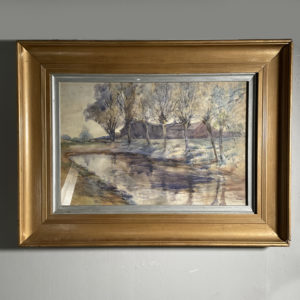
Pollarded Willows by Ernest R Fox (1883-1919)
£440Pollarded Willows by Ernest R Fox (1883-1919)
depicting a row of trees by a pond with farm buildings in the background£440 -
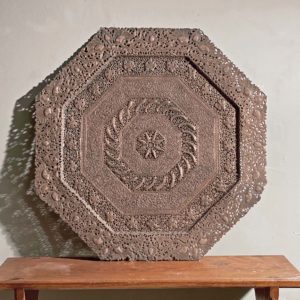
A hand-worked copper tray of intricate design,
£430A hand-worked copper tray of intricate design,
of octagonal form, pressed, pierced, punched and chased with varied foliate motifs,£430 -
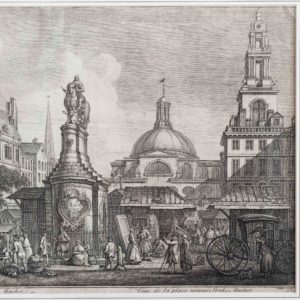
The Stocks Market,
£425The Stocks Market,
A mounted and gilt framed engracing depicting the Stocks Market in the City of London by Henry Fletcher after the painting by Joseph Nicholls. The Stocks Market existed between 1282 and 1737 on the current site of the Mansion House and has given it's name to the Bourses of the English speaking world. The statue, of Charles II trampling Oliver Cromwell underoot was the subject of a satirical verse from the pen of Andrew Marvell: "But a market, as some say, doth fit the King well, Who the Parliament too — and revenue doth sell; And others, to make the similitude hold. Say his Majesty too — is oft purchased and sold."£425 -
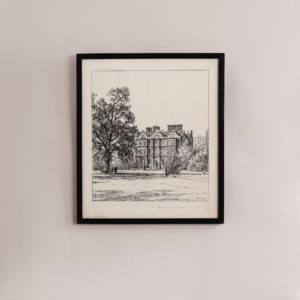
Kew Palace by Hubert Williams (1905-1989)
£425Kew Palace by Hubert Williams (1905-1989)
Kew Palace. Hubert Williams was an accomplished artist and illustrator who had the confidence to include the detail of everyday life in his views. Signed. Framed£425 -
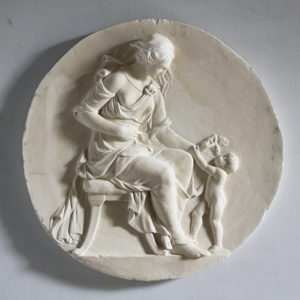
An English plaster relief-cast figurative roundel,
£425An English plaster relief-cast figurative roundel,
the seated female figure modelled in relief proffering grapes to a needy putto,£425 -
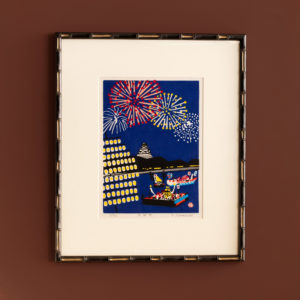
Tenjin Festival (天神祭)
£420Tenjin Festival (天神祭)
Born in Kobe 1923, Yuzaburo started studying woodblock print making with his father when he was eight years old. At the age of nineteen, his skill was such that he exhibited at the 11th Nihon Hanga Kyōkai (Japan Print Association) exhibition, winning a first prize, but it was not until he graduated from Kwansei Gakuin University in 1947, an education that was interrupted by the 1942 wartime Student Mobilization Order., that he became a full-time print maker. After the death of his father in 1965, Yūzaburō was to go on to become a leader in the creative print genre (sosaku hanga) in the Kansai region. was a member of Japan Print Association and a member of Kokuga Association£420 -
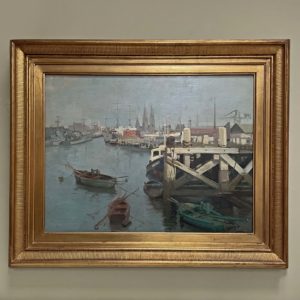
‘Ostende’, a framed oil on artist’s board,
£420‘Ostende’, a framed oil on artist’s board,
depicting the port of Ostend, in moulded gilt composition frame; signed, titled and dated to the front and reverse,£420 -
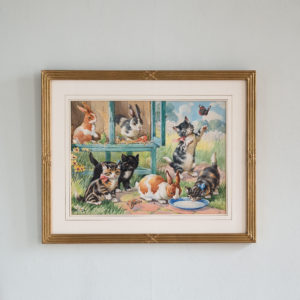
Kittens and Rabbits
£420 -
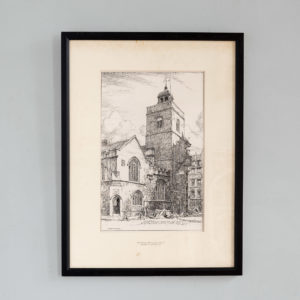
All Hallows, Barking by the Tower by Hubert Williams (1905-1989)
£420All Hallows, Barking by the Tower by Hubert Williams (1905-1989)
All Hallows, Barking by the Tower. Hubert Williams was an accomplished artist and illustrator who had the confidence to include the detail of everyday life in his views. Signed. Framed£420 -
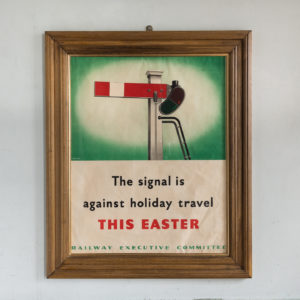
‘The signal is against holiday travel this Easter’
£420‘The signal is against holiday travel this Easter’
Born in Yarmouth, Reginald Mayes’ career began in the design studio of the Eastern Daily Press in Norwich. He moved to London where he designed water marks for paper manufacturers and studied life drawing at the Regent Street Polytechnic and Lithography under Gardiner, Clive. In the early 1930s he became chief staff artist at the London Midland and Scottish Railway public relations department, designing leaflets and posters. In the Second World War, Mayes produced a wide range of anti-travel and propaganda posters for the Railway Executive Committee. They discouraged railway travel with some humorous slogans such as ‘The signal is against holiday travel this Easter’. After the war he did freelance work before retiring to Kent where he relaxed painting landscapes.£420 -
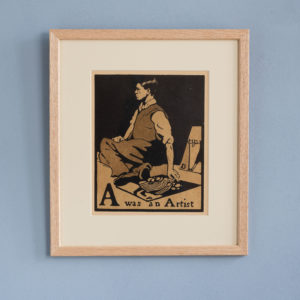
An Alphabet by William Nicholson, A was an Artist,
£400 eachAn Alphabet by William Nicholson, A was an Artist,
Nicholson was recommended by his friend, James McNeil Whistler to the publishers Heinemann as an original and expert wood-cut artist. The relationship with the publisher was highly successful, establishing Nicholson’s reputation as an illustrator. Between 1897 and 1900 he illustrated five works: An Alphabet, An Almanac of Twelve Sports, Twelve Portraits, London Types, and The Square Book of Animals.£400 each -
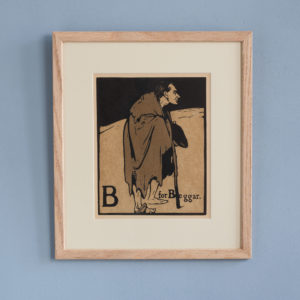
An Alphabet by William Nicholson, B for Beggar,
£400 eachAn Alphabet by William Nicholson, B for Beggar,
Nicholson was recommended by his friend, James McNeil Whistler to the publishers Heinemann as an original and expert wood-cut artist. The relationship with the publisher was highly successful, establishing Nicholson’s reputation as an illustrator. Between 1897 and 1900 he illustrated five works: An Alphabet, An Almanac of Twelve Sports, Twelve Portraits, London Types, and The Square Book of Animals.£400 each -
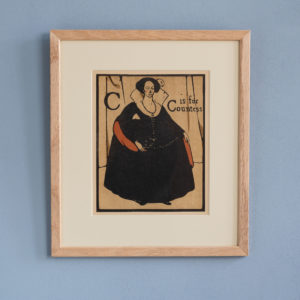
An Alphabet by William Nicholson, C is for Countess,
£400 eachAn Alphabet by William Nicholson, C is for Countess,
Nicholson was recommended by his friend, James McNeil Whistler to the publishers Heinemann as an original and expert wood-cut artist. The relationship with the publisher was highly successful, establishing Nicholson’s reputation as an illustrator. Between 1897 and 1900 he illustrated five works: An Alphabet, An Almanac of Twelve Sports, Twelve Portraits, London Types, and The Square Book of Animals.£400 each -
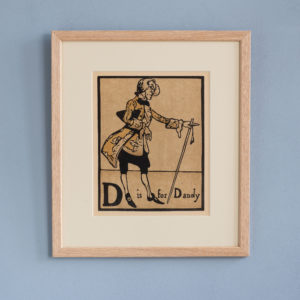
An Alphabet by William Nicholson, D is for Dandy,
£400 eachAn Alphabet by William Nicholson, D is for Dandy,
Nicholson was recommended by his friend, James McNeil Whistler to the publishers Heinemann as an original and expert wood-cut artist. The relationship with the publisher was highly successful, establishing Nicholson’s reputation as an illustrator. Between 1897 and 1900 he illustrated five works: An Alphabet, An Almanac of Twelve Sports, Twelve Portraits, London Types, and The Square Book of Animals.£400 each -
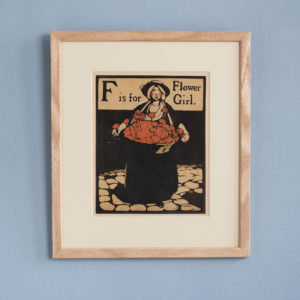
An Alphabet by William Nicholson, F is for Flower Girl,
£400 eachAn Alphabet by William Nicholson, F is for Flower Girl,
Nicholson was recommended by his friend, James McNeil Whistler to the publishers Heinemann as an original and expert wood-cut artist. The relationship with the publisher was highly successful, establishing Nicholson’s reputation as an illustrator. Between 1897 and 1900 he illustrated five works: An Alphabet, An Almanac of Twelve Sports, Twelve Portraits, London Types, and The Square Book of Animals.£400 each -
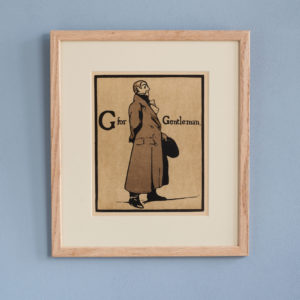
An Alphabet by William Nicholson, G for Gentleman,
£400 eachAn Alphabet by William Nicholson, G for Gentleman,
Nicholson was recommended by his friend, James McNeil Whistler to the publishers Heinemann as an original and expert wood-cut artist. The relationship with the publisher was highly successful, establishing Nicholson’s reputation as an illustrator. Between 1897 and 1900 he illustrated five works: An Alphabet, An Almanac of Twelve Sports, Twelve Portraits, London Types, and The Square Book of Animals.£400 each -
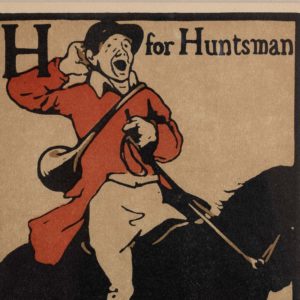
An Alphabet by William Nicholson, H for Huntsman,
£400 eachAn Alphabet by William Nicholson, H for Huntsman,
Nicholson was recommended by his friend, James McNeil Whistler to the publishers Heinemann as an original and expert wood-cut artist. The relationship with the publisher was highly successful, establishing Nicholson’s reputation as an illustrator. Between 1897 and 1900 he illustrated five works: An Alphabet, An Almanac of Twelve Sports, Twelve Portraits, London Types, and The Square Book of Animals.£400 each -

An Alphabet by William Nicholson, I for Idiot,
£400 eachAn Alphabet by William Nicholson, I for Idiot,
Nicholson was recommended by his friend, James McNeil Whistler to the publishers Heinemann as an original and expert wood-cut artist. The relationship with the publisher was highly successful, establishing Nicholson’s reputation as an illustrator. Between 1897 and 1900 he illustrated five works: An Alphabet, An Almanac of Twelve Sports, Twelve Portraits, London Types, and The Square Book of Animals.£400 each
Featured Items
-
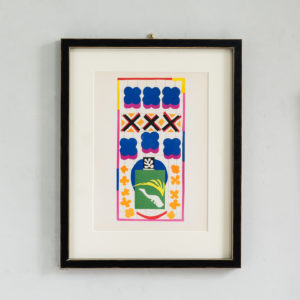
Henri Matisse, ‘The Last Works of Henri Matisse’
£900 eachHenri Matisse, ‘The Last Works of Henri Matisse’
From Verve Vol. IX No. 35/36 published by Tériade under the title 'The Last Works of Henri Matisse'£900 each -
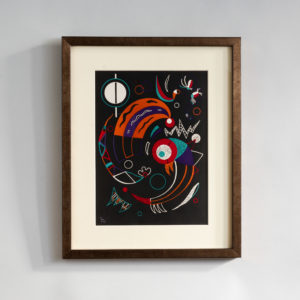
Comets by Wassily Kandinsky, Verve Vol. 1 / No. 2.
£800Comets by Wassily Kandinsky, Verve Vol. 1 / No. 2.
The Verve Review was a purposefully luxurious. It ran from 1937 to 1960, but with only 38 editions available, due to the high degree of design and editorial work dedicated to each issue. Each edition contained unique lithographic prints, commissioned by the editor, and each cover a double-page lithograph elaborated by one of the artists contained within. It was the brainchild of its editor Stratis Eleftheriades, a Greek National who moved to Paris in the early thirties to take part in the growing Modernist movement, writing under the name of Teriade.£800 -
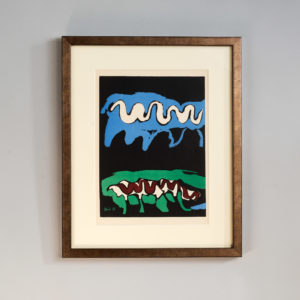
The Four Elements, Earth by Francisco Bores, Verve Vol. 1 / No. 1.
£600The Four Elements, Earth by Francisco Bores, Verve Vol. 1 / No. 1.
The Verve Review was a purposefully luxurious. It ran from 1937 to 1960, but with only 38 editions available, due to the high degree of design and editorial work dedicated to each issue. Each edition contained unique lithographic prints, commissioned by the editor, and each cover a double-page lithograph elaborated by one of the artists contained within. It was the brainchild of its editor Stratis Eleftheriades, a Greek National who moved to Paris in the early thirties to take part in the growing Modernist movement, writing under the name of Teriade.£600 -

The Dance, by Henri Matisse, Jan – March 1939 / No. 4.
£1,200The Dance, by Henri Matisse, Jan – March 1939 / No. 4.
The Verve Review was a purposefully luxurious. It ran from 1937 to 1960, but with only 38 editions available, due to the high degree of design and editorial work dedicated to each issue. Each edition contained unique lithographic prints, commissioned by the editor, and each cover a double-page lithograph elaborated by one of the artists contained within. It was the brainchild of its editor Stratis Eleftheriades, a Greek National who moved to Paris in the early thirties to take part in the growing Modernist movement, writing under the name of Teriade.£1,200

